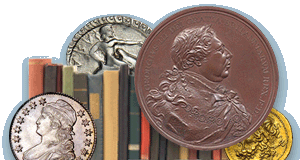
PREV ARTICLE
NEXT ARTICLE
FULL ISSUE
PREV FULL ISSUE
LOOSE CHANGE: MARCH 16, 2025Here are some additional items in the media this week that may be of interest. -Editor Larry Jewett of Coin World published a short article about the Smithsonian's exhibit of Tenino, WA wooden money. Here's an excerpt - see the complete article online. -Editor
Recently, Wayne Fournier, current Thurston County (Washington) Commissioner and former mayor of Tenino, had the opportunity to visit the display, where he was re-acquainted with a familiar initiative. The exhibit features Tenino's 2020 COVID wooden money alongside the original wooden currency printed in 1932, demonstrating how an innovative, community-driven solution from the Great Depression was revitalized to address the challenges of the 2020 pandemic. The initiative received national and international attention, symbolizing not just local economic action, but also the power of community leadership in times of adversity.
To read the complete article, see:
We've discussed this phenomenon before - Google promoting weird-ass articles with headlines like "Rare Bicentennial Quarter Worth $2.5 MILLION" and "This Lincoln Wheat Penny Valued at $3.5 Million, Still in Circulation" (both seen in my feed this morning). Charles Morgan of CoinWeek published this piece with the sad headline "Dumb People Are Paying $1,000 or More for Bicentennial Quarters on eBay". Here's an excerpt - see the complete article online. -Editor Call me old fashioned, but I'm the kind of fella who believes in paying an honest price for an honest product. And I believe there's an honest price for every kind of collectible and a justifiable reason for any collector to pursue any area of collecting if they so desire. I say that because today, I think we need to talk about the 1776-1976 Bicentennial Quarter, a perennial favorite among collectors and an eternal chestnut for SEO companies looking to hoodwink Google. I've written about this before, but the TL:DR of it is that, thanks to flaws in Google's algorithm, tens of thousands of articles have been written claiming this common coin still found in circulation is worth big bucks. Some of these spammers even claim the coin is worth hundreds of millions of dollars. I'm not kidding. Let's call it for what it is: a big lie. And this big lie is hurting people. Until humans take a bigger role in curating the type of content that Google and other social media companies disseminate, disinformation will continue to proliferate, and no amount of human expertise will be able to outshout a computer algorithm. I've done my part, but it remains to be seen if the refutation of a noted numismatic expert will be able to out-disseminate the 1976 quarter's Big Lie. It's anyone's guess how many of the recorded eBay sales are real, vs. bids by shills to create a trail of fake transactions. But as always, Buyer Beware. -Editor
To read the complete article, see:
Wayne Pearson passed along this article promoted by lobbyists for the zinc planchet makers. -Editor Eliminating the penny won't save the government money. In fact, such a move would have a significant negative impact on the U.S. Mint's cost structure. Many overhead expenses at the Mint would remain and would need to be absorbed by other coins, increasing their per-unit costs. Additionally, without the penny, the demand for nickels would rise to fill the gap in small-value transactions. Since each nickel costs nearly 14 cents to produce, this shift would drive up overall production expenses for the government. Rather than saving money, eliminating the penny would increase and redistribute financial burdens. "Many Mint overhead costs would remain and have to be absorbed by other coins without the penny," said Mark Weller, Executive Director of Americans for Common Cents. "Also, there would be greater demand for expensive nickels, which means even more costs," Weller added.
To read the complete article, see:
Wayne Homren, Editor The Numismatic Bibliomania Society is a non-profit organization promoting numismatic literature. See our web site at coinbooks.org. To submit items for publication in The E-Sylum, write to the Editor at this address: whomren@gmail.com To subscribe go to: Subscribe All Rights Reserved. NBS Home Page Contact the NBS webmaster 
|

